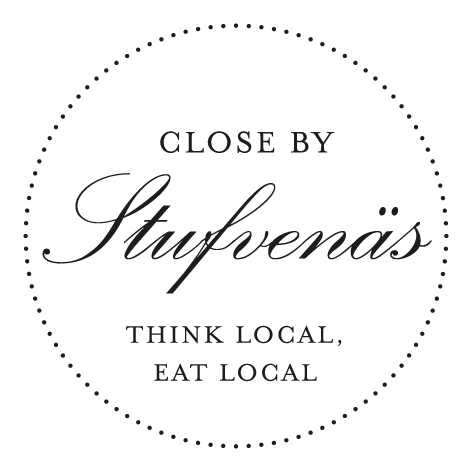At Stufvenäs Gästgifveri, we aim to preserve the traditional Småland Christmas dishes during the classic Christmas dinner. Some dishes have historical origins while others are more modern.
We have created two different quality labels so that you, as our guest, can have the best dining experience with us.
Enjoy your meal!
Made by Stufvenäs is our own quality label indicating which food is prepared from scratch, with carefully selected ingredients, in our kitchen by our skilled kitchen team.

Close by Stufvenäs is our quality label for really good and carefully selected locally produced products and ingredients.
Christmas bread differed significantly from the bread eaten daily. Primarily, it was baked as loaf bread. Additionally, wort was used as the dough liquid, and if one was well-off, dried fruits such as apples, figs, and raisins were added. The bread was also flavored with syrup, cloves, cinnamon, and cardamom.
The countdown to Christmas is called “the day before dipping day.” During Christmas preparations, it was practical to quickly dip some bread in the broth from the Christmas ham, which often stood on the stove. Originally, dipping bread in the pot was not a typical Christmas dish but something necessary to soften old, hard bread so it could be eaten. Almost like today’s fondue.
Christmas porridge was practical festive food when the family gathered to eat together. Porridge was not only a main dish at Christmas but also during mowing and harvest feasts. However, in the past, people did not eat rice porridge but barley porridge.
Today’s pickled herring originates from the salted herring that was eaten daily in the past. Salted Baltic herring was on the table almost every day in the Småland villages back then. It was eaten much more often than meat. So, a worn-out everyday dish has, with the help of spices, sauces, and various flavorings, been transformed into a delicacy in our time.
The oldest Scandinavian term for Christmas celebrations was “to drink Christmas.” The Christmas beer had to be of the best quality. As a precursor to our modern-day Christmas dining at restaurants, there was the village farmers’ pre-Christmas feast, where people went around the farms tasting each other’s Christmas beer. Since home brewing ceased, various mixed drinks like “mumma” have emerged. The most famous and beloved is Julmust, which was launched in 1910.
Glögg has existed since the Middle Ages and was created because the wine had to be spiced to mask its poor quality. It was then heated to kill mold and other impurities. But it wasn’t until the late 19th century that it was mentioned as a specific Christmas drink. Nowadays, glögg is a warming year-round drink.
Hazelnuts and apples have a long tradition as Christmas candy in Småland. Exotic fruits such as figs, dates, raisins, foreign nuts, and chocolate and marzipan figures came when colonial trade developed during the 19th century.
The reason we eat so much pork during Christmas is that during the self-sufficiency era, people only ate salted meat during the rest of the year. But during the large autumn slaughter, one or two pigs were usually saved and slaughtered just before Christmas and enjoyed fresh, considered a great delicacy. However, Christmas ham was not part of the Christmas table in the farming society. The hams were usually saved until summer and cut into smaller pieces. Most of the pork was boiled in the past, and the fatty broth was used, for example, for dipping bread in the pot. Christmas ham dates back to the late 17th century but was primarily eaten by the upper classes.
According to some sources, the dish is attributed to the opera singer Per Adolf “Pelle” Janzon in the 19th century. He became known for serving a “six” with beer, schnapps, and anchovy casserole, which supposedly gave rise to the name Jansson’s Temptation for this type of casserole. He may have been inspired by anchovy dishes with similar content. However, the dish’s name was not widely accepted until 40 years after Janzon’s death, well into the 20th century.
Our most Swedish national dish. But meatballs exist all over the world under different names and flavors. Today, it is most common to fry our meatballs, but in the 18th and 19th centuries, they were boiled like frikadeller. It is quite a modern phenomenon to grind meat into mince. However, finely chopped meat for sausages and other dishes is historically a common method to utilize all parts of the animal and make it easier for people with poor dental health.
Lutefisk, also called stockfish, was a Christmas dish in many Småland homes. Fresh fish was hard to come by during winter. In the past, lutefisk was eaten as dried fish. Thin slices were cut and pounded to make them more chewable and dipped in butter.
Source: Smaken av östra Småland & Öland, Nationalencyklopedin, Nordiska museet